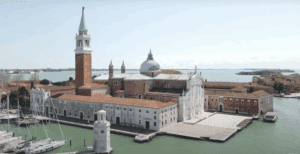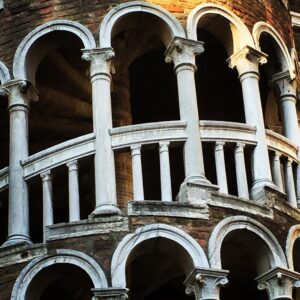Venice is one of those places that makes even the smartest travelers stop and think. You step off a boat, see palaces seemingly floating on water, canals instead of streets, and ask yourself the same question everyone does: “Wait… how is this city even standing?” 🤔
The answer isn’t magic — it’s a mix of brilliant medieval engineering, human stubbornness, and a whole lot of wood. Yes, wood. Millions of wooden poles, to be precise. And the story behind them is even more fascinating than you’d imagine.
Let’s peel back the layers — literally — and uncover how Venice rose out of the mud to become one of the most extraordinary cities ever built. (Don’t worry, we’ll make it cooler than your old history textbook.) 👇
🧠 Step 1: Start with a Swampy Lagoon
Before the canals, the gondolas, and the glittering marble palaces, there was… mud. A lot of it.
Over 1,500 years ago, the Venetian Lagoon was little more than a vast swamp — a shifting landscape of tidal flats, marshes, and small sandy islands. Not exactly the ideal real estate for a global maritime power.
But around the 5th and 6th centuries, waves of refugees fled here from mainland cities like Padua and Aquileia to escape barbarian invasions. The lagoon’s geography made it the perfect hiding spot. No invading army wanted to trudge through waist-deep mud and unpredictable tides just to attack a few fishermen.
Still, there was one tiny issue: mud isn’t exactly a great foundation for a city. 🫧
So how did the early Venetians transform a swamp into a stable home?
🌿 Step 2: Find Some “Solid-ish” Ground
Those first Venetians looked for the highest, driest patches of land they could find — natural islands like Rialto, Torcello, and Murano. These were slightly elevated sandbanks that sat above the tides (most of the time).
They began with simple wooden huts, elevated on platforms to keep them dry. But as the community grew — and trade flourished — they needed something far more permanent. The problem was, every time they tried to build with stone, the structures slowly started to sink into the soft lagoon mud.
That’s when Venetian ingenuity kicked in.
🌲 Step 3: Hammer a Forest into the Mud 🪵🔨
Here’s where Venice becomes an engineering miracle. To build stable foundations, early Venetians came up with a bold idea: hammer millions of wooden piles into the lagoon bed.
These poles — typically made of alder, oak, or larch — were shipped from forests in northern Italy, Slovenia, Croatia, and even as far as the Alps. Each one was about two to four meters long. Workers would drive them deep into the clay and sand layers beneath the water, using massive wooden hammers and sheer human force.
Once driven down, the piles formed a dense, interlocked forest beneath the city. And here’s the mind-blowing part:
- The wood doesn’t rot because it’s underwater with no oxygen.
- Over centuries, minerals from the water slowly petrified the wood — turning it almost as hard as stone.
- This network of piles distributed the weight of buildings evenly, creating a rock-solid base for an entire city.
So no, Venice doesn’t “float” — it sits on top of an invisible forest of wooden pillars, locked in place by science, salt, and centuries of careful maintenance. 🌲🌊
👉 Want to see where it all began? Join our Off-the-Beaten-Path Orientation Tour — we’ll show you parts of the city where you can still see ancient structural traces beneath your feet.
🧱 Step 4: Add Stone Platforms on Top
Once those wooden piles were secure, Venetian builders placed horizontal beams across them, creating an interlocking platform. Then came a crucial layer: Istrian stone.
This ultra-dense, waterproof limestone — quarried from the Croatian coast — was shipped across the Adriatic and laid as a solid base for construction. It’s nearly impervious to water, making it the perfect foundation for canal edges, quays, and palace facades.
In essence, every Venetian building sits on a triple-decker foundation:
- Mud and clay — the original lagoon bed
- Wooden piles — millions of them, petrified and packed tightly together
- Istrian stone — forming the visible, watertight platform above the waves
The result? A city that stands firm despite being surrounded by water — for more than a thousand years. 🏗️
🏰 Step 5: Build Palaces Like You Mean It
With solid foundations in place, the Venetians began to build — and they didn’t hold back. Over the centuries, brick, marble, and mosaics transformed the lagoon into an architectural wonderland.
By the 14th and 15th centuries, Venice had become a global trading powerhouse. Merchants returning from Constantinople and the East used their wealth to build Gothic palaces, Byzantine domes, and Renaissance façades that still dazzle today.
What’s remarkable is that these elaborate structures remain stable because the weight is distributed evenly across the buried wooden piles — like a dancer balancing perfectly on tiptoe.
👉 You can admire the most stunning examples on our Private Grand Canal Boat Tour — we’ll glide past centuries of history built right on water.
🚤 Bonus: Why Venice Doesn’t Sink (At Least, Not Too Fast)
Let’s address the question every visitor asks: “If Venice is built on wood, why hasn’t it sunk by now?”
The truth is, Venice is slowly sinking — but not because of its wooden foundations. Those are rock-solid. The slow descent comes from natural subsidence (the ground compacting over time) combined with rising sea levels from climate change.
In the 20th century, industrial groundwater pumping near the mainland also accelerated the sinking, but that’s been stopped. Today, modern projects like the MOSE flood barrier system protect the lagoon from increasingly frequent high tides — known locally as acqua alta.
So, while the city does settle by a few millimeters per year, it’s not collapsing. In fact, those same wooden foundations have held strong for more than 1,200 years. 💪
👉 Curious about tides and flooding? Read our full Acqua Alta Guide to understand how Venetians live (and thrive) with water every day.
🔍 The Science Behind the Miracle
Here’s what really makes Venice’s construction unique: it combines natural chemistry and human creativity.
- The lagoon’s low oxygen and high mineral content keep wood from decaying.
- Over centuries, calcium salts crystallize within the fibers, essentially turning the wood into stone.
- Each building’s foundation behaves like a sponge — flexible enough to adapt to water movement without cracking.
Modern engineers have studied these techniques for decades. In fact, Venice’s “wooden city beneath the city” has inspired modern floating and pile-based architecture around the world — from Amsterdam to Dubai.
🧠 Fun Facts to Impress Your Friends
- Venice stands on an estimated 60 million wooden piles. 😳
- Many are still the originals — more than 500 years old.
- The Rialto Bridge alone rests on 12,000 piles.
- Underwater, the wood doesn’t rot — it mineralizes, becoming tougher over time.
- If you could drain the canals (please don’t), you’d see a forest of wooden stakes holding up the entire city.
👉 Want to explore these hidden layers of history? Join our Doge’s Palace & St. Mark’s Basilica Private Tour — where you’ll uncover the stories behind Venice’s most enduring symbols of power and faith.
⚒️ Keeping Venice Standing: Past, Present, and Future
Venice’s survival isn’t just a historical feat — it’s an ongoing effort. Every year, engineers, artisans, and conservation experts monitor the city’s structures, restoring foundations and reinforcing walls.
Some traditional techniques haven’t changed much since the Middle Ages. Wooden piles are still used to reinforce bridges and quays, and the city’s masons still rely on lime mortar mixed with lagoon sand. It’s a perfect example of how ancient craftsmanship and modern science coexist in Venice.
Even with rising sea levels, Venice continues to adapt — not by fighting the water, but by learning to live with it. That’s the Venetian way.
✨ Final Thought
Venice wasn’t built on water — it was built in the water, above the mud and on top of millions of wooden poles. It’s one of humanity’s most remarkable architectural achievements — proof that with creativity, patience, and persistence, even the impossible can stand for over a millennium.
So next time you glide along the Grand Canal, look down. Beneath your feet lies a hidden wooden world — a submerged forest silently supporting one of the most beautiful cities on Earth. 🇮🇹🌊
✨ Explore Venice from the Ground Up with Our Private Tours ✨
Want to keep exploring the city’s secrets? Don’t miss:
- What Is Acqua Alta, and When Does It Happen?
- How Do Locals Live with So Many Tourists in Venice?
- Venice for First Timers
- Hidden Gems of Venice Only Locals Know About
Venice doesn’t defy nature — it partners with it. And that partnership, between water and willpower, is what keeps La Serenissima standing tall after more than a thousand years. 🌊💪
How exactly was Venice built on water?
Venice was constructed on millions of wooden piles driven deep into the lagoon’s clay and sand. These oxygen-free conditions prevent the wood from rotting, while minerals in the water gradually petrify it — turning each pole as hard as stone. On top of this invisible forest, builders placed Istrian stone platforms that became the base for palaces, churches, and bridges.
Why doesn’t Venice sink if it’s built on wood?
It’s a mix of chemistry and genius. The wood foundations are preserved underwater without oxygen, making them stronger over time. The city’s slow sinking is caused not by decaying wood but by natural ground compaction and rising sea levels. Modern engineering — including the MOSE flood-barrier system — now helps protect Venice from the highest tides.
Can I visit places that show how Venice was built?
Absolutely. You can explore the Doge’s Palace and its ancient foundations, see canal structures on our Venice Off-the-Beaten-Path Orientation Tour, and admire the lagoon’s architecture from the water on our Private 1-Hour Boat Tour of the Grand Canal and Hidden Canals. Each experience reveals the extraordinary engineering that keeps Venice standing after more than a thousand years.







